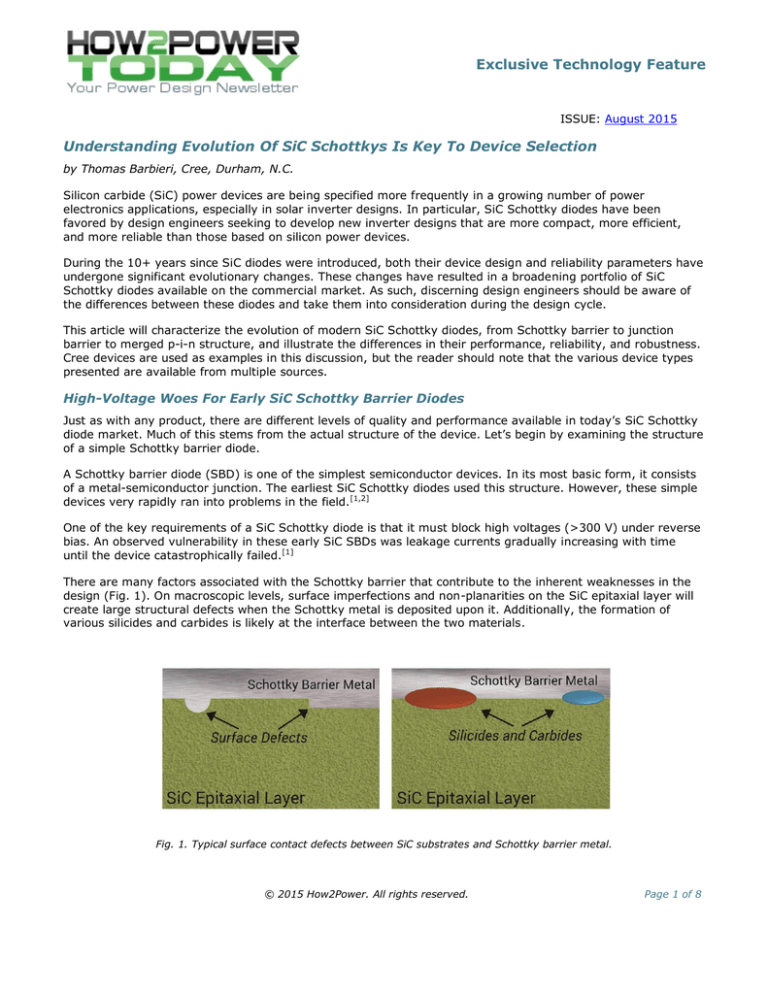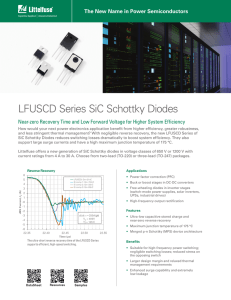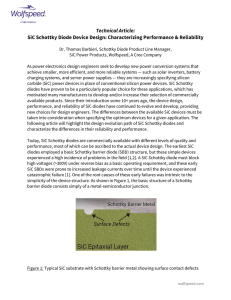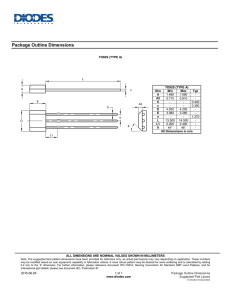
Exclusive Technology Feature
ISSUE: August 2015
Understanding Evolution Of SiC Schottkys Is Key To Device Selection
by Thomas Barbieri, Cree, Durham, N.C.
Silicon carbide (SiC) power devices are being specified more frequently in a growing number of power
electronics applications, especially in solar inverter designs. In particular, SiC Schottky diodes have been
favored by design engineers seeking to develop new inverter designs that are more compact, more efficient,
and more reliable than those based on silicon power devices.
During the 10+ years since SiC diodes were introduced, both their device design and reliability parameters have
undergone significant evolutionary changes. These changes have resulted in a broadening portfolio of SiC
Schottky diodes available on the commercial market. As such, discerning design engineers should be aware of
the differences between these diodes and take them into consideration during the design cycle.
This article will characterize the evolution of modern SiC Schottky diodes, from Schottky barrier to junction
barrier to merged p-i-n structure, and illustrate the differences in their performance, reliability, and robustness.
Cree devices are used as examples in this discussion, but the reader should note that the various device types
presented are available from multiple sources.
High-Voltage Woes For Early SiC Schottky Barrier Diodes
Just as with any product, there are different levels of quality and performance available in today’s SiC Schottky
diode market. Much of this stems from the actual structure of the device. Let’s begin by examining the structure
of a simple Schottky barrier diode.
A Schottky barrier diode (SBD) is one of the simplest semiconductor devices. In its most basic form, it consists
of a metal-semiconductor junction. The earliest SiC Schottky diodes used this structure. However, these simple
devices very rapidly ran into problems in the field.[1,2]
One of the key requirements of a SiC Schottky diode is that it must block high voltages (>300 V) under reverse
bias. An observed vulnerability in these early SiC SBDs was leakage currents gradually increasing with time
until the device catastrophically failed.[1]
There are many factors associated with the Schottky barrier that contribute to the inherent weaknesses in the
design (Fig. 1). On macroscopic levels, surface imperfections and non-planarities on the SiC epitaxial layer will
create large structural defects when the Schottky metal is deposited upon it. Additionally, the formation of
various silicides and carbides is likely at the interface between the two materials.
Fig. 1. Typical surface contact defects between SiC substrates and Schottky barrier metal.
© 2015 How2Power. All rights reserved.
Page 1 of 8
Exclusive Technology Feature
On a microscopic level, the Schottky metal and SiC semiconductor will have different crystal structures and
lattice parameters, which results in significant atomic-level incongruities at the junction. All of these factors lead
to structural defects across the plane of the junction. Under reverse bias, these defects act as initiation points
for leakage currents. Additionally, due to localized temperature increases associated with the leakage currents,
the defects can grow larger with time;[3] and, as the defects grow larger, they carry more leakage current,
progressing until the device can no longer block the specified voltage.
Junction Barrier Design Improved Reliability
The solution to this problem was to incorporate a design known as the junction barrier Schottky, or JBS.[4] The
primary modification of the JBS design is the addition of regularly spaced p+ wells located just below the
Schottky barrier. Fig. 2 demonstrates how this improvement substantially increased the reliability and
robustness of the diode.
Fig. 2a displays a basic SBD under reverse bias. The electric field gradient extends across the thickness of the
n- drift layer, with the peak electric field value occurring at the barrier, exactly where the defects are. In the
case of the JBS diode, the p+ wells create a series of homojunctions with the surrounding n- drift layer.
Fig. 2a. Structure (left) and electric field distribution under reverse bias (right) of a pure Schottky
diode.
Fig. 2b. Structure (left) and electric field distribution under reverse bias (right) of a JBS diode.
© 2015 How2Power. All rights reserved.
Page 2 of 8
Exclusive Technology Feature
As with any semiconductor junction, a depletion region exists at the interface of the p + wells and the n- drift
layer. When reverse bias is applied to the Schottky diode, the electric field associated with the p-n depletion
region impinges against the applied electric field. As can be seen in Fig. 2b, the resultant peak electric field is at
the bottom of the p+ wells, far from the defects of the Schottky barrier. Consequentially, the JBS diode has
significantly lower leakage currents and higher breakdown voltage than basic Schottky barrier diodes.
Merged P-I-N Structure Enhances Surge Current Handling
After more than a decade of innovation and on-going product development, the SiC junction barrier Schottky
diode has evolved into the merged p-i-n Schottky, or MPS.[5] MPS diodes have all of the advantages of JBS
diodes under reverse bias while also including a unique feature under forward bias.
In the MPS structure, the p+ wells have been altered to form a p-i-n junction with the substrate material. During
normal forward operation, these p-i-n junctions remain inactive, not contributing to the forward current.
However, during forward transient events, the p-i-n junctions turn on, dramatically increasing the forward
current-carrying capability of the diode (Fig. 3.) This results in a device with much greater forward surge
current handling capability than a simple Schottky diode.
Fig. 3. A structural diagram of a Cree MPS diode under transient surge conditions.
Fig. 4 compares a curve tracer measurement of an MPS diode and a pure Schottky diode under forward current.
During high surge-current conditions, pure Schottky diodes can transition into thermal runaway and potentially
be destroyed due to the associated high forward-voltage drop. Alternately, under these same conditions, MPS
diodes transmit the same high current with minimal increase in forward voltage drop, and are thus much more
rugged and robust devices than pure Schottky diodes.
Field data supports this conclusion. Cree has been offering commercially available JBS and MPS SiC diodes for
more than ten years, and has accumulated an estimated one trillion device hours in the field. The total failures
in time (FIT) rate for this population is 0.095, which is less than one-twentieth the comparable value for silicon
devices, a long-established technology (Table 1.)
© 2015 How2Power. All rights reserved.
Page 3 of 8
Exclusive Technology Feature
Fig. 4. Curve tracer measurement of an MPS diode (blue trace) and a non-MPS diode (red trace).
The activation of the p-i-n diodes causes the upward divergence of the MPS diode above 6 V.
Table 1. FIT data for Cree’s SiC MPS and JBS Schottky diodes
Product
Device structure
Device hours
FIT (fails/billion
hours)
CSDxxx60
JBS
483,000,000,000
0.05
C2Dxx120
JBS
171,000,000,000
0.43
C3Dxxx60
MPS
481,000,000,000
0.02
C4Dxxx120
MPS
46,800,000,000
0.04
1,183 billon
0.099
Total
In recent years, pure SBD devices have reemerged in the SiC Schottky diode marketplace in an effort to provide
customers with a lower-price option. While it must be assumed that these manufacturers have found an
acceptable solution to the failure mode of the original SiC SBD devices, these modern SBDs still retain the
inherent flaw of having the peak electric field at the Schottky junction; and, as such, still have higher leakage
currents and lower breakdown voltages than MPS diodes.
Moreover, they also completely lack the advanced forward surge protection of the MPS diodes. Ideally, a
comparison of FIT data for MPS vs. SBD devices should have been included with Table 1. However, since
commercially available SiC SBD devices have only been on the market for a brief period of time, field data is
limited. Recent analysis has shown that these modern pure Schottky diodes demonstrate unstable operation
after continuous avalanche testing, an effect not observed in MPS devices.[6]
© 2015 How2Power. All rights reserved.
Page 4 of 8
Exclusive Technology Feature
How can informed consumers determine whether the diode they are purchasing is SBD, JBS, or MPS? Device
manufacturers don’t necessarily broadcast the structure of their SiC diodes, but this information is usually
available upon request. If not, a quick comparison of datasheet values can provide insight into the device
structure.
For instance, simple SBD devices will have higher reverse-leakage currents than comparable JBS and MPS
devices, particularly at higher temperatures. Furthermore, MPS diodes will have greater forward-surge ratings
than both JBS and SBD. The difference is difficult to quantify due to variations in measurement parameters, but
the MPS surge will be at least 2x greater than a comparable SBD.
As an example, Table 2 compares the datasheet values of Cree MPS diodes to typical commercially available
SBD diodes.
Table 2. A comparison of Cree MPS diodes to commercially available SiC SBD diodes. (Comparisons are based
on specifications provided in publicly available datasheets.)
Diode
structure
Non-repetitive forward
surge, IF,SM (A)
Reverse leakage current, IR
(µA) @ TJ = 175°C
TC = 25°C,
10 µs pulse
Typical
Max
400
40
300
Cree
C4D05120A
1200-V 5-A
Schottky
MPS
TC = 25°C,
10 ms half
sine
46
Company A
1200-V 5-A SiC
Schottky
SBD
23
87
65
n/a
Company A
1200-V 6-A SiC
Schottky
SBD
25
100
>650
>1500
To go one step further, the enterprising engineer can acquire several samples of each diode and test them in
the laboratory to explore device behavior that is not normally contained in datasheets. As displayed in Figs. 5
and 6, placing the diodes under extreme forward and reverse bias will also reveal their structure.
Under forward bias at 5x to 10x the rated current, MPS devices exhibit an upward parabolic turn as the p-i-n
diodes turn on. In contrast, the SBD devices exhibit a curve that flattens asymptotically as the device saturates
and heads toward failure. Additionally, under reverse bias, the SBD has higher leakage than both the JBS/MPS
devices, and begins to transition into breakdown at lower voltages than the JBS/MPS diode.
© 2015 How2Power. All rights reserved.
Page 5 of 8
Exclusive Technology Feature
Fig. 5. Forward bias comparison of a 10-A MPS diode from Cree versus a 10-A SBD diode from
company A.
Fig. 6. Reverse bias comparison of a 650-V MPS diode from Cree versus 650-V SBD diodes from
company A and company B at 125°C.
© 2015 How2Power. All rights reserved.
Page 6 of 8
Exclusive Technology Feature
Conclusion
All new technology must go through the technology lifecycle. SiC Schottky diodes that use the junction barrier
Schottky or merged p-i-n Schottky structure have been on the commercial market for more than a decade. As
such, it can be argued that these diodes have transitioned into the maturity phase of their lifecycles, and the
initial issues and field failures associated with their market introduction have long been resolved. In contrast,
although pure SiC Schottky barrier diodes were originally introduced before JBS and MPS diodes, current SBD
devices should still be considered to be within the introductory phase due to the long hiatus between their initial
introduction and recent reentry into the commercial market.
Some SBD manufacturers have already released their second generation, but many are still in their first design
iteration. Although there is no reason to assume that these manufacturers aren’t taking every precaution to
produce a high-quality, reliable product, there is a higher risk of infant mortality failures inherent in these
younger technologies; and, unfortunately, the limited size of the current field FIT data prevents a firm
conclusion from being drawn.
Commercial SiC MPS diodes, such as those offered by Cree are currently on their fifth design iteration, and
there is a substantial amount of field data supporting the high reliability of this design. Thus, when combined
with the enhanced surge capability and higher breakdown voltage of the MPS design, engineers should feel
confident designing with this established technology, which is rugged, robust, and reliable.
References
1. “On the dV/dt Rating of SiC Schottky Power Rectifiers,” by Kaustuva Acharya and Krishna Shenai,
Proceedings of the Power Electronics Technology 2002 Conference, October 2002, pages 672-677.
2. “Reliability considerations for recent Infineon SiC diode releases,” by M. Holz et al., Microelectronics
Reliability, v47 (2007), pages 1741–1745.
3. “Influence of overgrown micropipes in the active area of SiC Schottky diodes on long term
reliability,” by R. Rupp et al., Materials Science Forum, vols. 483-485 (2005), pages 925-928.
4. “An Overview of Cree Silicon carbide Power Devices,” by J. Richmond et al, IEEE Workshop on
Power Electronics in Transportation (WPET), 2004, Detroit.
5. “ ‘2nd Generation’ SiC Schottky diodes: A new benchmark in SiC device ruggedness,” by R. Rupp, et
al., Proceedings of the 18th International Symposium on Power Semiconductor Devices & IC’s, June
4-8, 2006, Naples, Italy.
6. “Avalanche Behaviour and its Temperature Dependence of Commercial SiC MPS Diodes: Influence of
Design and Voltage Class,” by R. Rupp et al., as presented at the 26th International Symposium on
Power Semiconductor Devices & IC's, June 15-19, 2014, Waikoloa, Hawaii.
7.
“600 V, 1- 40 A, Schottky Diodes in SiC and Their Applications” by A. Agarwal and others.
About The Author
Thomas Barbieri has spent the past 14 years of his career filling various roles
within the semiconductor industry, He started with Freescale Semiconductor,
where he acted as a process engineer for MEMS sensors and as a failure analysis
engineer/materials characterization specialist supporting all semiconductor
products. For the last 8 years, Tom has been with Cree, having served as an R&D
scientist with the Materials business unit and a product engineer with the LED
Components business unit, prior to joining Cree Power as a marketing engineer.
© 2015 How2Power. All rights reserved.
Page 7 of 8
Exclusive Technology Feature
Prior experience included an assistant professorship in the Physics Department of Simmons College. Tom
received his PhD in Materials Science and Engineering from Cornell University in 1999.
For further reading on SiC power devices, see How2Power.com’s section on Silicon Carbide and Gallium Nitride
Power Technology.
© 2015 How2Power. All rights reserved.
Page 8 of 8





